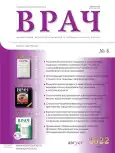Long-term results of mesodiencephalic modulation therapy in patients with diabetic distal polyneuropathy
- Authors: Kuzminov G.G.1, Marchenkova L.A.1, Kiyatkin V.A.1
-
Affiliations:
- National Medical Research Center for Rehabilitation and Balneology
- Issue: Vol 33, No 8 (2022)
- Pages: 80-84
- Section: From Practice
- URL: https://journals.eco-vector.com/0236-3054/article/view/114677
- DOI: https://doi.org/10.29296/25877305-2022-08-17
- ID: 114677
Cite item
Abstract
Diabetic polyneuropathy is one of the most common and significant complications of type 2 diabetes mellitus (DM2). The multicomponent pathogenesis of the development of diabetic polyneuropathy requires an integrated approach using both pharmacological and non-drug therapy. Objectives: to investigate the long-term results of the use of mesodiencephalic modulation in patients with diabetic distal polyneuropathy on the background of type 2 diabetes mellitus (DM2). Material and methods. The study included 120 patients aged 30 to 70 years with an established diagnosis of DM2, glycosylated hemoglobin level <8.5%, and diagnosed with severe or severe diabetic polyneuropathy of the lower extremities (more than 5 points on the NSS scale), who were simple randomization were divided into main and control groups. Patients of the main group received 13 procedures of mesodiencephalic modulation against the background of standard medical therapy for type 2 diabetes. In the control group, only standard therapy for DM2 was used. Examination of patients included the measurement of height, weight, body mass index, pain syndrome, severity of symptoms of diabetic polyneuropathy and fasting glycemia and was carried out at baseline, immediately after completion of therapy and dynamics after 3, 6 and 12 months after completion of treatment. Results. In patients of the main group, after a course of mesodiencephalic modulation, the achieved regression of neurological symptoms persisted for 8.04±0.27 months. Indicators of the dysfunctional score scale (NDS) 12 months after the end of treatment indicated a negative trend in patients of both groups. In patients of the control group, the manifestations of pain returned to the original (before treatment) values after 4.76±0.14 months, in the main group this period was 7.88±0.25 months. In contrast to the control, in patients of the main group, the body mass index returned to baseline after 3 months, and the level of fasting glycemia - after 6 months after completion of treatment. Conclusion. Data were obtained on the long-term preservation of the achieved effect after the use of mesodiencephalic modulation in patients with DM2 and the presence of diabetic polyneuropathy of the lower extremities.
Full Text
About the authors
G. G. Kuzminov
National Medical Research Center for Rehabilitation and Balneology
Email: MarchenkovaLA@nmicrk.ru
L. A. Marchenkova
National Medical Research Center for Rehabilitation and Balneology
Author for correspondence.
Email: marchenkovala@nmicrk.ru
доктор медицинских наук
V. A. Kiyatkin
National Medical Research Center for Rehabilitation and Balneology
Email: MarchenkovaLA@nmicrk.ru
кандидат медицинских наук, доцент
References
- International Diabetes Federation. IDF Diabetes Atlas. 10th edition. IDF; 2020.
- Care D., Suppl S.S. Cardiovascular Disease and Risk Management: Standards of Medical Care in Diabetes-2020. Diabetes Care. 2020; 43: S111-134. doi: 10.2337/dc20-S010
- Дедов И.И., Шестакова М.В., Викулова О.К. и др. Атлас регистра сахарного диабета Российской Федерации. Статус 2018 г. Сахарный диабет. 2019; 22 (2S): 4-61. doi: 10.14341/DM12208
- Куденцова Л.А., Давыдов Д.В., Чернавский С.В. и др. Классификация сахарного диабета: новый взгляд на проблему. Лечащий Врач. 2022; 5-6: 84-90. doi: 10.51793/OS.2022.25.6.015
- Морозов А.М., Сороковикова Т.В., Жуков С.В. и др. Диабетическая дистальная полинейропатия: профилактика, лечение и реабилитация (обзор литературы). Вестник медицинского института «РЕАВИЗ». Реабилитация, Врач и Здоровье. 2022; 12 (3): 68-77. doi: 10.20340/vmi-rvz.2022.3.CLIN.4
- Марченкова Л.А., Бадалов Н.Г., Герасименко М.Ю. и др. Современные возможности и перспективы физиотерапевтических и бальнеологических методов в лечении и реабилитации пациентов с диабетической нейропатией. Физиотерапия, бальнеология и реабилитация. 2016; 15 (6): 322-7. doi: 10.18821/1681-3456-2016-15-6-322-327
Supplementary files








